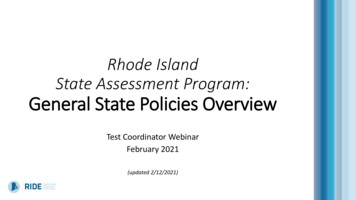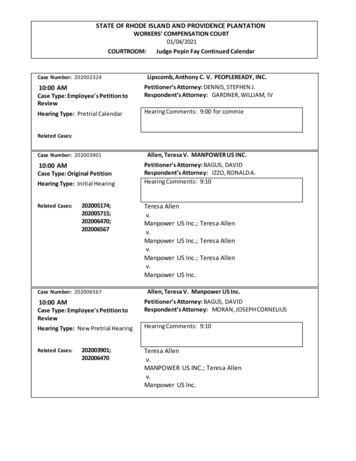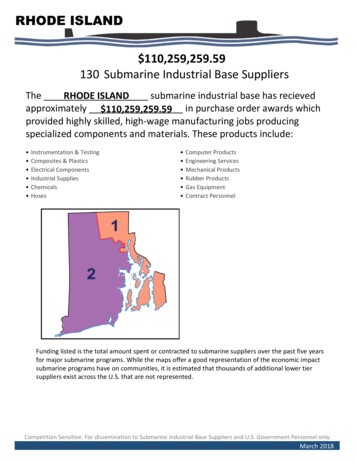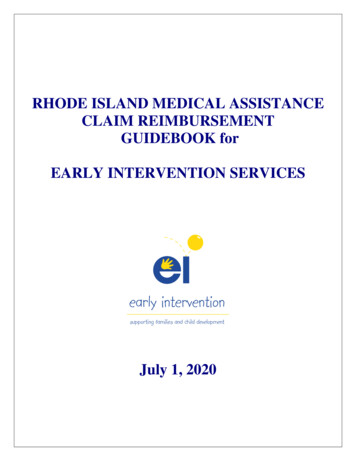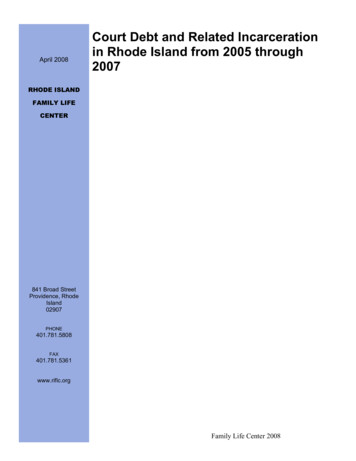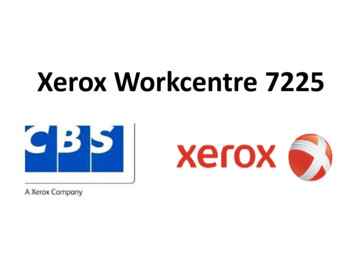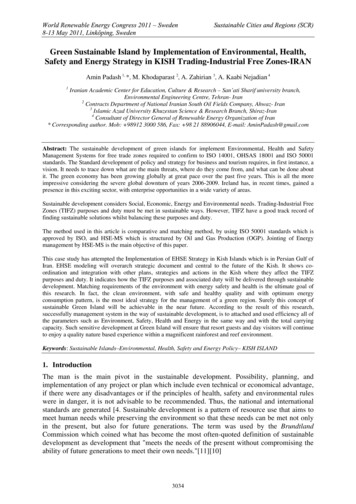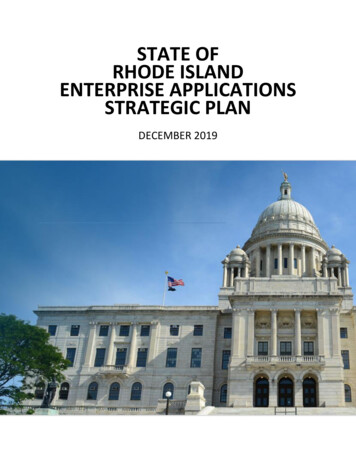
Transcription
STATE OFRHODE ISLANDENTERPRISE APPLICATIONSSTRATEGIC PLANDECEMBER 2019
ContentsExecutive Summary. 4Introduction . 4Objectives . 5Target Solution and Timeline . 5Staffing and Cost . 7Funding and Financing . 7Benefits . 9Critical Success Factors and Risk Mitigation . 10Organizational Change Management Approach. 10Integration Approach . 10Data Conversion Approach . 10Master Data Management Approach . 11Security Approach . 11Executive Summary Conclusion . 11Guide to this Document . 12I. Introduction . 13What is the Enterprise Applications Strategic Plan?. 13What Are Enterprise Applications, and Which Are In-Scope for the Strategic Plan? . 13What is the Case for Change? . 15II. Objectives. 17What Would Success Look Like? . 17What Are the Principles that Will Guide Us? . 17III. Target Solution and Timeline . 19Scope of Functionality. 19Required Core Finance and Human Resources . 20Desired Functionality Outside the Core . 22Grants Management . 22Time and Attendance . 22Talent Acquisition . 23Debt and Investment Management . 23Budget Development . 23Integration Layer . 231
Enterprise Business Intelligence . 23Procurement . 23Identity and Access Management. 23Deployment Method. 24Digital Capabilities and Intelligent ERP . 24Timeline. 25Pre-Implementation . 27Implementation . 28Post-Implementation . 30IV. Staffing and Cost . 32Staffing Plan . 32Cost Model . 35V. Funding and Financing . 37Funding Strategy . 37Financing Strategy. 38VI. Benefits . 40Hard Dollar Benefits . 41Information Technology . 41Human Resources . 42Payroll . 43Soft Dollar Benefits . 43VII. Critical Success Factors and Risk Mitigation . 46Organizational Change Management Approach. 46Component 1: Value Realization. 47Component 2: Change Readiness and Culture . 47Component 3: Communications . 48Component 4: Training . 48Integration Approach . 49Integration Planning. 49Integration Development. 51Data Conversion Approach . 52Data Conversion Process. 53Master Data Management Approach . 532
Identifying Master Data . 53Master Data Governance . 54Security Approach . 55Key Security Considerations. 56Role of Security in the Overall Program . 56VIII. Conclusion. 57Appendix . 59Appendix I: Example Key Performance Indicators for HR/Payroll and Finance . 59Appendix II: Role Descriptions for Program by Phase . 67Appendix III: Methodology . 76Appendix IV: Acronym Dictionary . 77Appendix V: Inventory of Relevant Audit Findings . 783
Executive SummaryIntroductionThe Enterprise Applications Strategic Plan is the foundation for Rhode Island’s multi-year effort totransform its enterprise technology and business processes to better meet the needs of the State, itsresidents, and its partners.The need for a comprehensive Strategic Plan arose from the recognition by Rhode Island leadership thatthe State must:1) Reduce high risk of process or system failure on certain systems the State relies upon to performits essential administrative responsibilities2) Provide greater modern functionality to those charged with managing the State’s resources,enabling improvements in how work is performed3) Address audit findings (detailed in Appendix V) related to insufficient controls and the lack of acomprehensive approach to replacing aging administrative systemsThis report was created in collaboration between the State and Accenture, a consulting firm that theState engaged through a competitive request for proposals (RFP) process.The Strategic Plan provides a roadmap that will guide the State’s transformation from numerous,antiquated, non-integrated business applications to a unified, modern, cloud-based Enterprise ResourcePlanning (ERP) system. An ERP combines an organization’s main resources – its people, money,information, and assets – and merges it into information to strategically guide and manage.Functionality in-scope of this initiative include: Human Resources applications Payroll applications Finance applications Enterprise Support applicationsThe transformation of Rhode Island’s enterprise applications is less an opportunity and more of anecessity. State leaders have critical compliance and performance responsibilities that they cannot feelcomfortable in accomplishing with existing processes and technology. They are unanimous in theirsupport of this enterprise applications modernization effort, and in their conviction that the status quofails to meet Rhode Island’s needs. The risks of inaction far outweigh the cost of upgrades in capability.This program or initiative is about targeting the resources we have to make a bigger difference for morepeople. The list below summarizes a subset of the reasons why Rhode Island must modernize itsenterprise applications. Decision-makers are unable to receive accurate information in a timely manner Rhode Island’s systems are outdated – even in comparison to its State government peers Current systems are susceptible to single points of failure and security risk The handful of experts the State is reliant upon to keep the current systems operational arenearing – or already eligible for – retirement Antiquated systems and processes hinder the State’s ability to attract the next generation oftalent Errors and rework resulting from non-integrated systems and duplicate data entry waste timeand money4
Enterprise technology powers the State – and has a downstream impact on its ability to serve itsresidentsResidents now expect public organizations to nimbly anticipate needs and deliver services moreefficiently and effectively. Reforms must start in the “back office” – by the leaders responsible forenterprise functions including finance, audit, grants, budget, payroll, and human resources. Thesefunctions, and the systems that support them, are the engines of public service value delivery. Thecurrent enterprise applications are a constraint to performance. The transformation of these enterpriseapplications, described in this Strategic Plan, is an enabler to performance. All dates in this documentare directional pending funding and approval to proceedObjectivesDue to the many challenges, the State requires a different future vision – both for completing asuccessful initiative and for delivering the improvements that an ERP will enable. The program strives togenerate the following vision:Although it may be the smallest state, Rhode Island has once again shown the way for its peers.Its new Enterprise Resource Planning system has allowed the State to transform itself into amodel of efficiency. Despite challenges, ranging from constrained budgets to the intricacies ofreplacing a patchwork of paper processes and aging technology, the State and its partners wereup to the task, completing the project on-time and on-budget. But beyond just delivering asuccessful go-live, the State has delivered real benefits to its taxpayers – millions in savings,reduced risk to the State’s data, improved customer service, and timely and accurateinformation provided to decision-makers. The new ERP makes it easier for State employees todo their jobs and enables better service to the public.Target Solution and TimelineRhode Island will pursue a Software-as-a-Service (SaaS)/Cloud solution for ERP. In comparison to atraditional, on-premises deployment, this approach offers the following advantages:1. Speed: Speed to deliver, ease of use, and access via mobile devices2. Cost reduction: Reduced demand on in-house IT staff, upgrades are included in service, theState is always on the latest version, reduction in hardware costs3. Flexibility and Scalability: Software is configurable with the ability to grow with the needsand size of the State4. Innovation: Software stays up-to-date with changing technology and leverages the softwarevendors’ investments in research and developmentFor core Finance and HR/Payroll functionality, the State will seek proposals that include a single,integrated set of software applications. For functionality outside of the core, the State will allow thevendors, through the RFP process, to propose options to accomplish these functions via their ownsoftware or via specialized “best-of-breed” software.Figure 1 below displays the high-level target solution. Functionality supporting business processes insidethe solid-line box, labelled Core Finance and HR, will be acquired as a single instance from a single ERPsoftware vendor. Functionality supporting business processes in the six dotted-line boxes (Grants,5
Debt/Investments, Budget, Enterprise Business Intelligence, Time and Attendance, and TalentAcquisition) will be acquired based on the evaluation of vendor proposals.Figure 1: High-Level Solution ArchitectureMultiple options were considered for delivering the target solution within a timeframe that allowsRhode Island to maximize speed to business value while minimizing risk. For planning purposes, theState selected a 39-month implementation timeframe, shown below in Figure 2.iFigure 2: High-Level Program Timeline*6
Staffing and CostShould this Strategic Plan be approved and funded, the staffing plan includes a combination of existingand new State personnel. During the Pre-Implementation phase, a governance team consisting of StateIT, Human Resources, and Finance leadership will be responsible for obtaining approval and funding,overseeing the RFP process, and launching other readiness activities. A core team and extended teamsupport these efforts.During the Implementation phase, the governance team and core team evolve into the ProgramManagement and Oversight group. A new Project Management team is mobilized. The Implementationteam reports to the Project Management team, organized into the HR/Payroll, Grants, Finance,Organizational Change Management, and Technical teams. The State has adopted an integrated teamconcept, with State employees matched with consultant labor for many of the tasks.The Post-Implementation phase is made up solely of State resources. The management and governanceteam will provide guidance and strategy for the ongoing operation of the new enterprise applications.Additionally, HR/Payroll, Grants, and Finance each have an operation and maintenance (O&M) teamconsisting of State resources supporting end-users for business functionality, technical issues, andongoing training and Change Management.The Cost Model below in Figure 3, shows the total budget request for net new resources of 73.7 millionfrom FY21-FY27.Figure 3: Net New Program Cost by Fiscal Year*Funding and FinancingThe recommended funding approach is a combination of appropriations from the operating budget andcapital budget. The recommended financing approach is to issue Certificates of Participation (COPs) toprovide the cash for net new resources needed for implementation, combined with reimbursement ofdebt service and post-implementation costs from stakeholders. Figure 4 below shows the budgetrequirements by Fiscal Year before financing.7
Figure 4: Budget Requirements by Fiscal Year Before Financing*COPs are a tax-exempt financing mechanism used by Rhode Island and other states to finance expensesfor large-scale information technology programs. Two rounds of COPs are assumed, one
Debt/Investments, Budget, Enterprise Business Intelligence, Time and Attendance, and Talent Acquisition) will be acquired
